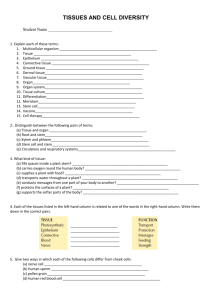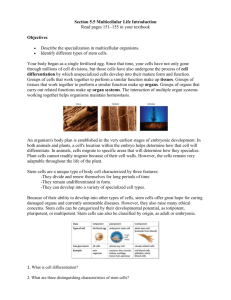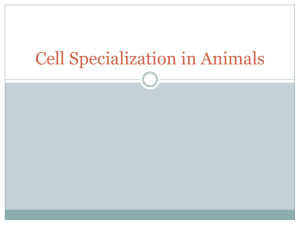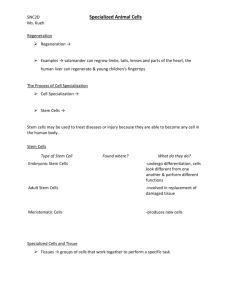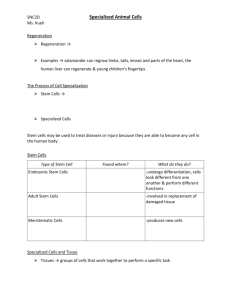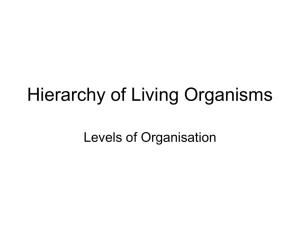stem cell
advertisement
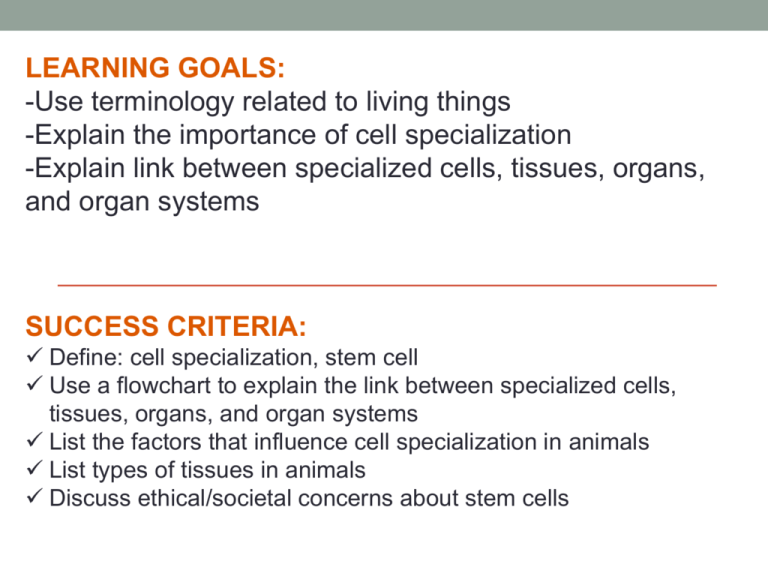
LEARNING GOALS: -Use terminology related to living things -Explain the importance of cell specialization -Explain link between specialized cells, tissues, organs, and organ systems SUCCESS CRITERIA: Define: cell specialization, stem cell Use a flowchart to explain the link between specialized cells, tissues, organs, and organ systems List the factors that influence cell specialization in animals List types of tissues in animals Discuss ethical/societal concerns about stem cells CELLS, TISSUES, ORGANS, SYSTEMS -Levels of Organization -Types of cells -Types of tissues -Cell Differentiation -Stem cells MINDS-ON https://www.youtube.com/watch?v=BmFEoCFDi-w Cell Specialization A society relies on its specialists to function efficiently/properly. Similarly, a multicellular organism relies on different types of cells to function efficiently/properly. Blood Cell Bone Cell Muscle Cell Brain Neuron Specialized Cells – a cell that can perform a specific function In order to effectively perform their specialized functions, cells have developed specific physical and chemical characteristics that best suit their role. i.e. Muscle cells require large amounts of energy, thus they contain a lot of mitochondria Cells that produce mucous in the intestine have a lot of Golgi bodies Levels of Organization Unicellular organisms (i.e. Bacteria, algae etc...) are able to function independently without the direct help of other cells However, the specialized cells within multicellular organisms (i.e. bone cell, blood cell etc...) would not survive long if they became separated from their surrounding cells. The cells within multicellular organisms are organized into a hierarchy. Only by working together as a whole organism can these specialized cells survive and reproduce. Levels of Organization Organ Systems Organs Tissues Cells TISSUE o A collection of similar cells that perform a specific function. o In animals, there are FOUR types: ORGANS o A structure composed of different tissues working together to perform a complex body function o Common organs in animals include: Heart / Stomach / Lungs / Kidneys / Liver / Eyes / Brain / Intestines / Skin ORGAN SYSTEMS o A system of one or more organs and structures that work together to perform a major vital body function such as digestion or reproduction. o Most organs work within a single organ system. i.e. The stomach is part of the digestive system o Some organs may play a role in more than one system. i.e. The pancreas is part of the digestive system, as well as the endocrine system (glands that regulate the body by secreting hormones into the bloodstream). Human Organ Systems Cellular Differentiation All multicellular organisms begin life as a single cell zygote (fertilized egg) . As it undergoes a series of cell divisions, the cells are said to be in the process of cellular differentiation. This is where they begin to show specialization in their shape, contents, and function. The zygote is now called an embryo. FUN FACTS: Did you know...? During the early stages of embryonic development, many vertebrates (animals with a backbone) have remarkably similar forms/structures. Stem Cells https://www.youtube.com/watch?v=evH0I7Coc54 Stem Cells In animals, a cell that can differentiate into many different cell types is called a stem cell. Depending on the type of nutrients it receives and other environmental factors, different parts of its DNA can be turned on or off. This results in the formation of specific type of cell/tissue. Stem Cell Research In general, there are two types of stem cells: 1. Embryonic Stem Cells: Stem cells that are harvested early enough in the embryonic stage, so that they can be differentiated into any kind of cell. i) Early embryonic stem cells: Totipotent = capable of dividing and forming into a complete mature organism ii) Late embryonic stem cells: Pluripotent = capable of developing into many different cell types 2) Tissue/Adult Stem Cells: Harvested from the specialized tissue of mature organisms. These cells can only differentiate into certain types of cells. i.e. Tissue stem cells from the bone marrow can differentiate into white blood cells, red blood cells, or platelets. This procedure is often used to treat patients with Leukemia or other cancers that affect blood cells. Research in the field of stem cells holds great promise for organ/tissue transplants and regeneration. But it’s not without its controversies. However, since the umbilical cord contains a rich supply of tissue stem cells, some parents will have their child’s umbilical cords stored in a blood bank for future use THINK-PAIR-SHARE What are some ethical, legal, and social issues associated with STEM CELLS? Next Class… • Looking at animal and plant cells under the microscope! LEARNING GOALS: -Investigate specialized cells in the human body (or in plants) -Draw labelled biological diagrams SUCCESS CRITERIA: Use a microscope to differentiate between animal and plant cells Draw biological diagrams of plant and animals cells using checklist provided
